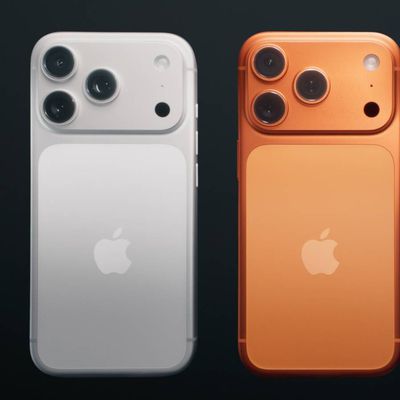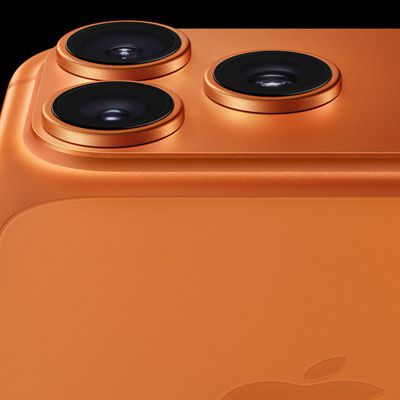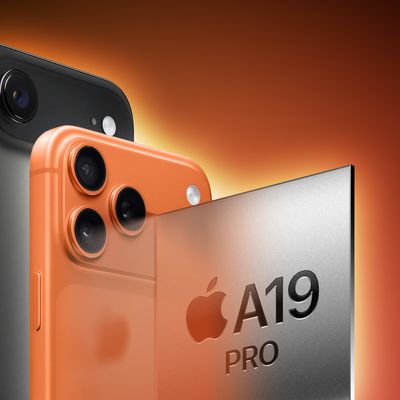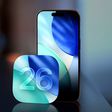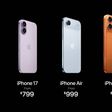Intel Looking Toward Retina Display PCs by 2013
As reported by Liliputing (via Electronista), Intel is envisioning the high-resolution "Retina" displays pushed by Apple in its iOS devices as the future of PCs, with comments at its Intel Developer Forum in Beijing noting that the company is supporting those plans with its chips.
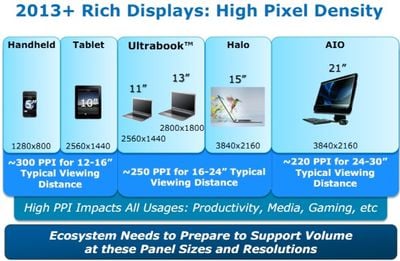
Specifically, Intel sees handheld and tablet devices targeting resolutions in the range of 300 pixels per inch (ppi), while notebook computers target roughly 250 ppi and all-in-one desktop computers register around 220 ppi.
So here’s what Intel sees happening in the computer space over the next few years:
- Phones and media players with 5 inch, 1280 x 800 pixel displays (this is already happening)
- Tablets with 10 inch, 2560 x 1440 pixel displays
- Ultrabooks with 11 inch, 2560 x 1440 pixel displays
- Ultrabooks with 13 inch, 2800 x 1800 pixel displays
- Laptops with 15 inch, 3840 x 2160 pixel displays
- All-in-one desktops with 3840 x 2160 pixel displays
As noted by 9to5Mac, Intel executive Kirk Skaugen specifically referred to these displays by the "Retina" term coined by Apple at the introduction of the iPhone 4 back in 2010. In his presentation, Skaugen mentioned that Intel's third-generation Core i-Series processors (also known as Ivy Bridge) will support Retina displays if manufacturers choose to offer them. This support is not new, however, as he also noted that the current second-generation Core i-Series chips (Sandy Bridge) also support Retina displays, although Ivy Bridge will mark a significant leap forward in graphics support.
Apple is of course rumored to be working toward releasing Retina-capable Macs, as evidenced by support for the "HiDPI" mode showing up in OS X Lion and Mountain Lion. Rumors have suggested that an updated 15-inch MacBook Pro set to appear in the near future could indeed carry a 2880x1800 screen capable of utilizing HiDPI mode to display sharper content.
Popular Stories
Apple today introduced the iPhone 17 Pro and iPhone 17 Pro Max.
Both devices feature a new aluminum unibody design, with the Ceramic Shield now protecting both the front and back sides. Apple says the front side is now Ceramic Shield 2, which offers 3x better scratch resistance, while the rear Ceramic Shield is advertised as 4x more resistant to cracks compared to the back glass on previous...
Apple continues to phase out the physical SIM card tray on iPhones, with the latest models relying solely on eSIM technology in more countries.
The new iPhone 17, iPhone 17 Pro, and iPhone 17 Pro Max support eSIMs only in these countries and regions, according to Apple:
Bahrain
Canada
Guam
Japan
Kuwait
Mexico
Oman
Qatar
Saudi Arabia
United Arab Emirates
Un...
Apple's new Live Translation feature for AirPods will be off-limits to millions of European users when it arrives next week, with strict EU regulations likely holding back its rollout.
Apple says on its feature availability webpage that "Apple Intelligence: Live Translation with AirPods" won't be available if both the user is physically in the EU and their Apple Account region is in the EU....
Apple held its annual iPhone event on Tuesday, September 9, to unveil the iPhone 17, ultra-thin iPhone Air, iPhone 17 Pro, and iPhone 17 Pro Max.
All of the new iPhone models will be available to pre-order starting Friday, September 12 at 5 a.m. Pacific Time / 8 a.m. Eastern Time in the U.S. and dozens of other countries, according to Apple. The release date for the devices is one week...
While the iPhone 18 Pro and iPhone 18 Pro Max are still a year away, there are already a few rumors about the devices that offer an early look ahead.
If you are skipping the iPhone 17 Pro and want to know about what to expect from the iPhone 18 Pro models, we have recapped a few of the key rumors below.
Under-Screen Face ID
In April 2023, display industry analyst Ross Young shared a...
Apple has confirmed the battery capacities for the iPhone 17, iPhone Air, iPhone 17 Pro, and iPhone 17 Pro Max models that were announced earlier today.
Apple is required to publish energy labels on its iPhone product pages in the EU, and they reveal the official mAh battery capacities for the devices.
Here are the battery capacities for each model, according to Apple:
iPhone 17:...
The first benchmark results for the A19 Pro chip in the iPhone 17 Pro, iPhone 17 Pro Max, and iPhone Air surfaced in the Geekbench 6 database today.
Based on these early results — which are unconfirmed — the A19 Pro chip across the Pro models and the iPhone Air appears to deliver up to 13% to 15% faster multi-core CPU performance compared to the A18 Pro chip in the iPhone 16 Pro...



